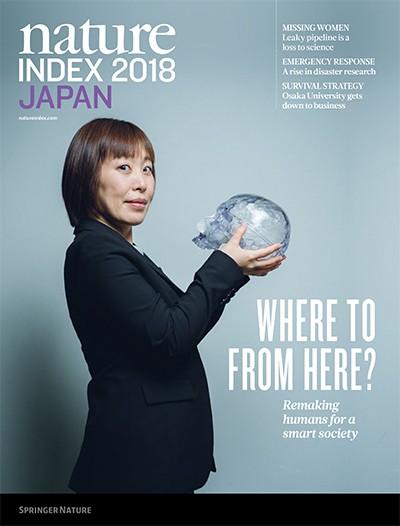
A researcher at the Control System Engineering Laboratory, at Hiroshima University, which is a big supporter of linking graduates with industry.Credit: Tamotsu Kashiwagi
For the past three years, Hirotaka Kawashima has been worried about his fate. The 37-year-old scientometrics researcher from Tokyo is among the thousands of early-career researchers in Japan on a short-term work contract. He may soon be out of a job.
“I am very worried,” says Kawashima, who has a doctoral degree in cognitive neuroscience and is employed as a research fellow at the National Institute of Science and Technology Policy (NISTEP) until March 2018. “I have no future positions,” he says. “Most of my researcher friends have fixed-term positions,” says Kawashima.
Kawashima and his colleague, Yasuhiro Yamashita, who is also on a fixed-term contract, recently analysed the academic employment database JREC-IN Portal, which is maintained by the Japan Science and Technology Agency. They found that 71% of the job postings for assistant professors, published between 2012 and 2015, were for limited terms.
With few prospects for landing a permanent job in academia or national research institutes, recent graduates and postdoctoral researchers in Japan are being forced to abandon their scientific ambitions.
The talent drain will make it more difficult to arrest the decline in Japanese science. A separate NISTEP study found that between 2004 and 2012, junior scientists contributed to almost 70% of the papers published by the top 44 most productive Japanese universities in the Web of Science database.
“Early-career researchers are important for conceiving and testing new ideas and introducing disruptive innovation. We need to create better policies that support them,” says Yuko Harayama, an executive member of the prime minister’s science advisory body, the Council for Science, Technology and Innovation.
In Japan, unlike many other research-intensive countries, PhD students largely have to cover their own school fees, pension and living expenses. Around half of postdocs are lucky enough to score a permanent position, but the best the rest can hope for after graduation is a five-year fixed contract, the longest that are generally permissible under the Labor Standards Act.
In 2016, the government set a target to increase the number of university researchers under 40 by 10% by 2020 from a starting point of 43,763 researchers in 2013.
Going private
The Japanese government has introduced several initiatives over the past decade to increase the number of permanent jobs available to young researchers. But these actions have yielded few measurable gains, says Harayama. Now, the government is making overtures to the private sector with a view to taking graduates outside academia entirely. “We really want to invite companies to be a part of this story,” says Harayama.
Toshiyuki Misu, a physicist who heads the Global Career Design Center at Hiroshima University, is facilitating this transformation. Before moving to Hiroshima in 2014, Misu spent nine years at NISTEP studying the Japanese graduate employment landscape.
He and his colleagues analysed the career paths of a quarter of the country’s postdoctorate population, finding that very few doctorate graduates ended up in industry.
Of the more than 3,800 researchers surveyed, only 68 joined the private research and development workforce. Three-quarters continued to work as postdoctoral researchers in academia. A 2012 survey of the entire Japanese postdoctorate population proved consistent: just 106 of the almost 13,000 researchers whose careers could be traced took up R&D positions in a company.
Since Misu’s study, the government has introduced several initiatives to encourage universities to form connections with companies as a conduit for science careers for younger generations.
Hiroshima has supported training on leadership and communication skills and internships at partnering companies for nearly 100 graduate students. The programmes are gradually convincing students, faculty, and companies of the merits of bringing PhD graduates into the corporate sector, says Misu. “We should inform industry that it needs these highly skilled researchers for innovation.”
More movement is afoot. In 2016, the government launched the Leading Initiative for Excellent Young Researchers to match 100 young scientists with tenure-track programmes in academia, government or industry every year, with the option for joint appointments.
And in 2017, it started a five-year programme to encourage young researchers to establish start-ups. “Young people are highly motivated to contribute to society and global challenges,” says Harayama. “We have to make sure that private companies understand that it is to their advantage to include them.”


 Stalled ambition
Stalled ambition
 Resistance to reform
Resistance to reform
 Relative gain
Relative gain
 Calling rikejo
Calling rikejo
 Partners in discovery
Partners in discovery
 Strength from weakness
Strength from weakness
 Pillars of a smart society
Pillars of a smart society
 Facing down disaster
Facing down disaster
 Access granted
Access granted
 Noble halls of discovery
Noble halls of discovery
 A guide to the Nature Index
A guide to the Nature Index








